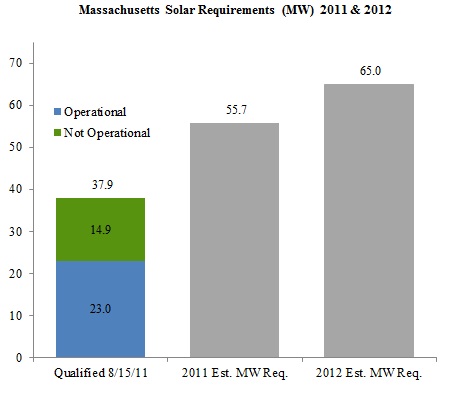Shortly before its summer recess, the Massachusetts Senate passed Amendment 18 to S. 1973 in a voice vote on July 23. Two weeks later, on August 7, 2015, Massachusetts Governor Charlie Baker released a net metering bill to rival S. 1973.
Both the Senate Bill and the Governor’s Bill address the net metering caps that are currently causing a slow-down in the Commonwealth’s solar development, and look to former Governor Patrick’s goal for the Commonwealth to install 1,600 megawatts of solar energy in Massachusetts by 2020. Earlier this year, the Baker-Polito Administration announced its support of the goal to achieve 1,600 MW by 2020. Accordingly, both S. 1973 and the Governor’s Bill propose to raise the net metering caps to meet the goal of 1,600 MW by 2020.
Under Amendment 18 to S. 1973, the Senate calls for raising the caps to 1,600 MW, and eliminating the caps thereafter (the elimination of the caps would apply to solar net metering facilities, with the exception that the maximum amount of generating capacity eligible for net metering by a municipality or other governmental entity shall be 10 megawatts), but the bill would do little else to change the value of a net metering credit. In addition to addressing the caps, the Amendment calls for Massachusetts regulators to “develop a solar incentive program to encourage continued development of solar…” with the goal of “develop[ing] a sustainable long-term framework that effectively balances promoting clean energy and costs to ratepayers,” to be implemented after the 1,600 MW target has been reached. Unfortunately, the Senate bill also attempts to limit the potential options for future programs, without much consideration for allowing the stakeholder process to consider all of the policy options presented by the Task Force in its Final Report (see below).
In contrast, Governor Baker’s Bill would substantially reduce the value of net metering credits in the Commonwealth. For solar projects over 10 kW on single phase, or projects over 25 kW on 3-phase, the value of net metering credits will be the average monthly clearing price in ISO-NE (that is, the wholesale retail rate). This would be a drastic change from the current value, which includes the value of all wires charges, such as distribution, transmission and transition charges. For other specific facilities, including municipal or other governmental entity (“MOOGE”) facilities, facilities for low-income off-takers and community shared solar facilities, the value of net metering credits will be based on the utility’s basic service kW charge, and will also exclude wires charges. The result of this exclusion in both categories is the value of credits being cut nearly in half. But like the Senate Bill, the Governor’s Bill also calls on Massachusetts regulators to “establish a solar incentive program for the development of distributed solar generation beyond 1,600 [MW] by solar photovoltaic facilities connected to a distribution or transmission system, which shall be a statewide program.”
Both the Senate Bill and the Governor’s Bill draw upon the recommendations from the Net Metering and Solar Task Force. The Net Metering and Solar Task Force was a group established last fall by the Massachusetts Legislature under Ch. 251 of the Acts of 2014, Section 7. The Task Force was responsible for reviewing the “long-term viability of net metering and develop recommendations on incentives and programs to support the deployment of 1600 MW of solar generation facilities in the commonwealth.” In its Final Report, the Task Force encouraged the Commonwealth to develop a solar incentive framework that would satisfy eight different program attributes, including promoting the orderly transition to a stable, equitable and self-sustaining solar market, and relying on market-based mechanisms and/or price signals as much as possible to set incentive levels such that the program would be readily adaptable to changing market conditions, all while minimizing costs, incentivizing diverse development, and promoting investor confidence. The Task Force cautiously qualified its recommendations by stating that “[t]he selection of a path for modeling is not an indication that a majority, or indeed any, of the Task Force members would like to see that path implemented,” and encouraged the DOER and DPU to lead a “comprehensive and transparent solar benefit/cost study to determine the value of impact of solar in Massachusetts” so that the Massachusetts Legislature, DOER, and DPU could more thoroughly evaluate the options presented by the Task Force, including the potential for an SREC III program to follow the highly successful SREC I and SREC II programs.
When the Legislature returns from its summer recess this Fall, the Joint Committee on Telecommunications, Utility and Energy will be confronted with the formidable task of reconciling these rival bills alongside the recommendations from the Net Metering and Solar Task Force, in order to help shape the future of solar in Massachusetts.
Tweet

